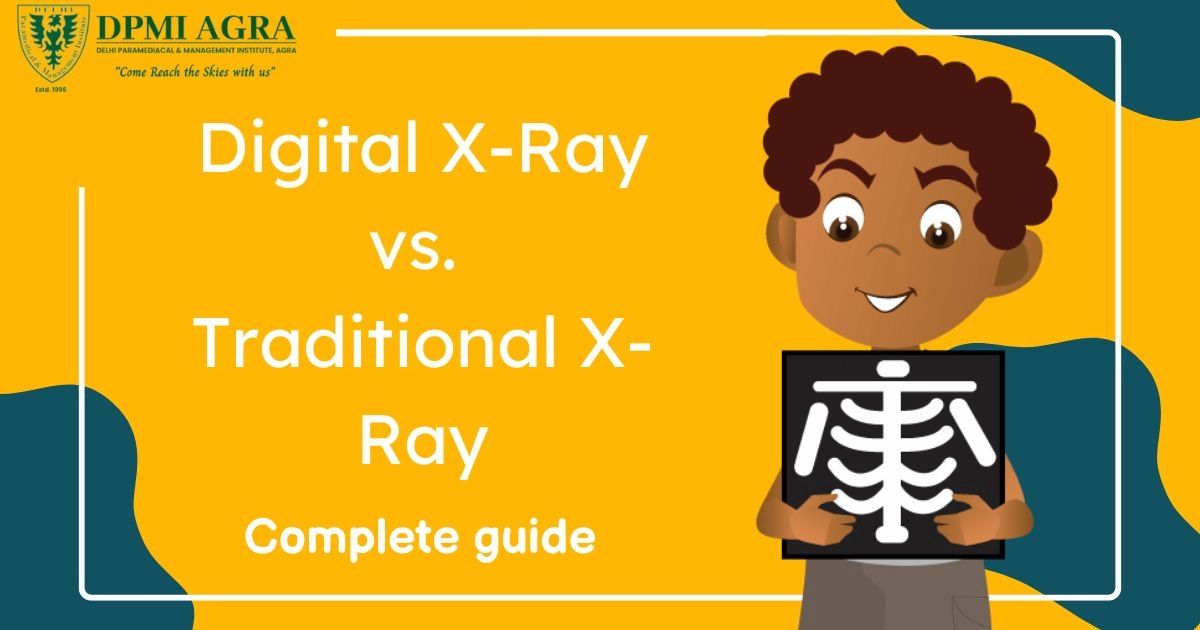Digital X-Ray vs. Traditional X-Ray: Complete Guide
Medical imaging has undergone a dramatic transformation in recent years. The discussion of Digital X-Ray vs. Traditional X-Ray is more relevant than ever. Patients and healthcare providers are shifting towards digital solutions that offer speed, precision, and safety. At DPMI Agra, we utilize state-of-the-art digital X-Ray technology to ensure quick, reliable, and accurate results. Whether it’s routine checkups, dental imaging, or complex diagnostic requirements, digital radiography is changing the way healthcare is delivered. In this article, we’ll explore everything you need to know about digital and traditional X-Ray, their differences, benefits, costs, and why digital X-Ray are becoming the preferred choice worldwide.
Understanding Traditional X-Ray
Traditional X-Ray, or film-based X-Ray, have been used for over a century. They work by passing X-ray radiation through the body to expose photographic film, capturing images of bones, teeth, or organs.
Key points about traditional X-Ray:
- Uses chemical film to capture images.
- Requires darkroom development, which can take time.
- Often involves higher radiation exposure compared to digital X-Ray.
- Physical storage is necessary, which can degrade over time.
While reliable and widely available, traditional X-Ray are slower and less flexible, and they lack the advanced features of digital imaging.
Rise of Digital X-Ray
Digital X-Ray, or digital radiography, have revolutionized medical imaging. They use digital sensors instead of film to capture images electronically. These images can be viewed instantly on computers, tablets, or integrated into electronic medical records (EMR).
Digital X-Ray trends in 2025:
- More than 70% of hospitals worldwide have adopted digital X-Ray.
- Radiation exposure is reduced by up to 80%, making them safer, especially for children and frequent scans.
- AI-assisted imaging is increasingly common, helping detect fractures, tumors, and dental issues faster.
- Digital X-Ray allow remote access, enabling telemedicine consultations and faster referrals.
The convenience, speed, and safety of digital X-Ray make them a clear winner in modern healthcare.
Digital X-Ray vs. Traditional X-Ray: Side-by-Side Comparison
| Feature | Traditional X-Ray | Digital X-Ray |
| Image Capture | Film-based | Digital sensor |
| Radiation Exposure | Higher | Lower (up to 80% reduction) |
| Processing Time | 10–30 mins | Seconds |
| Storage | Physical films | Digital/cloud storage |
| Image Enhancement | Limited | Zoom, contrast, annotation |
| Sharing | Manual | Instant electronic sharing |
| Cost Over Time | Moderate | Lower long-term cost due to efficiency |
Digital X-Ray provide enhanced image quality and faster workflows, making them suitable for both routine diagnostics and complex imaging needs.
Key Advantages of Digital X-Ray
- Safer for Patients: Reduced radiation exposure is particularly beneficial for children, pregnant women, and patients requiring repeated imaging.
- Instant Results: No waiting for film development. Doctors can analyze and share images immediately.
- Eco-Friendly: No chemical waste from film processing.
- Enhanced Image Quality: Zoom, contrast, and annotation features improve diagnostic accuracy.
- Efficient Storage: Digital files are easy to access, store, and share securely.
- Integration with EMR: Seamless integration with electronic health records for efficient patient management.
Limitations of Digital X-Ray
- High Initial Cost: Digital machines are expensive to purchase and maintain.
- Technical Training Required: Staff must be trained to use the equipment effectively.
- Dependence on Technology: System failures can temporarily halt imaging.
Despite these minor limitations, digital X-Ray outperform traditional methods in almost every aspect.
Cost Comparison: Digital vs. Traditional X-Ray
| Factor | Traditional X-Ray | Digital X-Ray |
| Equipment | Moderate | High upfront investment |
| Per Scan Cost | Moderate | Lower over time |
| Storage | Physical archive | Digital/cloud-based |
| Maintenance | Minimal | Software updates and calibration |
In the long term, digital X-Ray vs. film is more cost-effective due to efficiency, lower storage costs, and reduced radiation risks.
Choosing the Right Option for You
Here’s what to consider:
- Frequency of Imaging: If you need regular scans, digital is safer and faster.
- Budget Constraints: Traditional X-Ray may be cheaper upfront.
- Diagnostic Needs: Digital X-Ray provide superior clarity and image manipulation.
- Technology Access: Digital X-Ray integrate seamlessly with EMR and telemedicine.
At DPMI Agra, we recommend digital X-Ray for faster, safer, and precise diagnostics.
Real-World Applications and Trends
- Dental Imaging: Digital X-Ray are the standard for modern dentistry.
- Orthopedic Diagnostics: Detect fractures and joint problems quickly.
- Pediatric Care: Lower radiation exposure is safer for growing children.
- Telemedicine Integration: Remote consultations are faster with instant digital images.
- AI Diagnostics: Some digital X-Ray systems now integrate AI to detect abnormalities automatically.
These advancements show why digital X-Ray vs. traditional X-Ray is no longer just a choice—it’s the future.
Conclusion
The comparison of Digital X-Ray vs. Traditional X-Ray clearly favors digital technology. With faster results, lower radiation exposure, and enhanced image quality, digital radiography represents the future of medical imaging. At DPMI Agra, we use the latest digital X-Ray technology to provide accurate, safe, and quick diagnostics. Upgrade to digital imaging today for better healthcare outcomes.
FAQs
Q1: Are digital X-Ray safer than traditional X-Ray?
Yes, digital X-Ray reduce radiation exposure significantly.
Q2: Do digital X-Ray offer better image quality?
Absolutely. They allow image zoom, contrast adjustment, and annotation.
Q3: Are digital X-Ray more expensive?
Initial cost is higher, but long-term savings on film, storage, and repeated scans make them cost-effective.
Q4: How fast are digital X-Ray results?
Images are available almost instantly.
Q5: Can I share digital X-Ray with other doctors?
Yes, digital files can be securely shared electronically in seconds.

